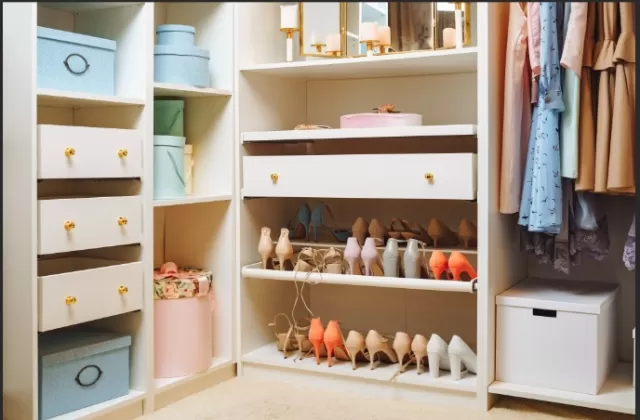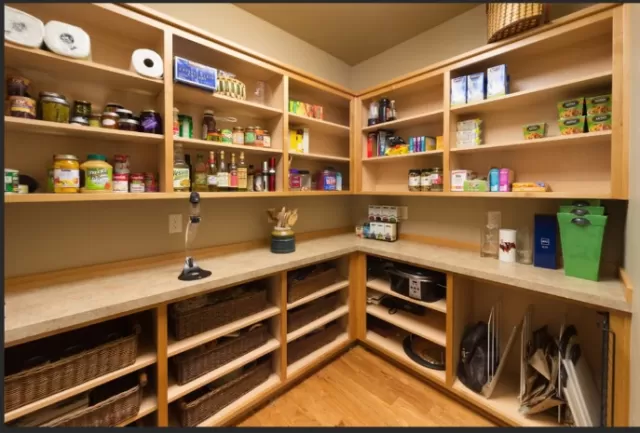Walk-In Pantry Ideas for a More Functional, Organized Space. Owning a walk-in pantry is a luxury, but maintaining its organization and cleanliness is an ongoing challenge. Despite having ample space, it’s not uncommon to feel overwhelmed and struggle to locate items efficiently. The dilemma arises in deciding what to keep and what to discard, leading to a pantry that may lack both functionality and style. Fortunately, achieving an organized, well-designed, and stylish walk-in pantry is within reach with the help of expert tips.
Maximize Shelving: Make the most of your walk-in pantry space by strategically placing shelves. Adjustable shelving allows flexibility to accommodate items of varying sizes, optimizing the use of vertical space.
Clear Containers: Utilize transparent, airtight containers for storing dry goods. This not only keeps items fresh but also provides a clear view of inventory, facilitating easy monitoring and replenishing.
Labeling System: Implement a comprehensive labeling system for containers, shelves, and storage areas. Clearly marked labels enhance visibility and ensure that items are returned to their designated spots, maintaining order.
Functional Zones: Organize the pantry by creating functional zones. Group similar items together, such as baking ingredients, canned goods, or snacks. This arrangement streamlines the retrieval process and minimizes the risk of overlooking items.
Proper Lighting: Ensure adequate lighting within the pantry. Well-lit spaces enhance visibility and contribute to a welcoming atmosphere. Consider installing under-cabinet lights or motion-activated lights for convenience.
Regular Decluttering: Periodically assess the pantry contents and declutter items that are expired, unused, or no longer needed. This practice prevents overcrowding and ensures that the pantry remains streamlined.
Invest in Drawers: Integrate pull-out drawers for efficient storage of smaller items. These drawers provide a clear view of contents and are more accessible than deep shelves, preventing items from getting lost.
Consider Layout: Thoughtfully plan the layout of your walk-in pantry. Opt for layouts such as U-shaped, L-shaped, or galley configurations based on available space and the intended use of the pantry.
Daily Maintenance: Cultivate a habit of daily maintenance. A few minutes each day dedicated to tidying up, returning items to their designated places, and ensuring a clutter-free environment goes a long way in preserving the organization.
Aesthetic Touches: Elevate the visual appeal of your walk-in pantry with aesthetic touches. Consider adding wallpaper, a pop of color, or decorative baskets to infuse personali
Optimizing Storage: Practical Tips for Large Spaces

In effectively managing spacious storage areas, such as walk-in pantries, the key is to maximize shelving and storage options.
According to Jane Stoller, a productivity and organizing expert, and author of “Decluttering for Dummies,” employing adjustable shelving is essential to accommodate items of various shapes and sizes, allowing you to make the most of vertical space.
To further enhance organization, consider integrating pull-out drawers, wire baskets, or bins for smaller items that tend to get misplaced.
These additional storage solutions ensure that every inch of the space is utilized efficiently. Stoller also emphasizes the importance of built-in racks for organizing spice jars and canned goods, streamlining accessibility and visibility in your storage area.
By incorporating these practical tips, you not only optimize the functionality of your storage space but also create a well-organized and accessible environment for a variety of items, from large to small.
Strategic Design: Crafting an Efficient Walk-in Pantry Layout
When creating a walk-in pantry, a thoughtful consideration of layout is paramount to achieve functionality, organization, and aesthetic appeal.
According to Liz Toombs, a certified interior decorator with PDR Interiors, selecting a layout that facilitates easy movement and access to shelves and items is crucial.
Toombs recommends exploring layouts such as U-shaped, L-shaped, or galley configurations based on the available space and the intended use of the pantry.
Factors such as whether the pantry will solely store food or also include appliances should inform the layout decision. The sizing of the pantry is equally important, with Toombs suggesting a minimum of 5×5 feet as a good starting point for an effective walk-in pantry.
By carefully considering these elements, homeowners can tailor the design to their specific needs, ensuring that the walk-in pantry not only serves its functional purpose but also complements the overall design and flow of the home.
Thoughtful layout planning contributes to an organized and efficient space that enhances the daily routines of those utilizing the pantry.
Optimizing Accessibility in Your Walk-In Pantry

Maximizing the functionality of your walk-in pantry involves prioritizing accessibility, according to Phillip Thomas, a New York-based interior designer.
To achieve this, consider strategies that enhance visibility and minimize clutter behind closed doors.
Thomas recommends incorporating open shelving units on the upper half of the pantry to allow for easy visibility and access to everyday items.
This design choice not only facilitates quick retrieval but also provides a visual inventory that aids in meal planning and grocery shopping.
For the lower half of the pantry, Thomas suggests the use of drawers to store items like snacks or smaller supplies.
Drawers offer a clear view of contents and are more accessible than deep shelves, preventing items from getting lost in the back. To further enhance practicality, consider using drawers with different depths.
Shallow drawers prove ideal for organizing smaller items like spices or utensils, preventing them from disappearing into the depths of deep shelves. On the other hand, deeper drawers accommodate larger items such as pots, pans, kitchen appliances, or bulk goods, ensuring convenient access without the need for excessive bending or reaching.
Illuminating Efficiency: The Impact of Task Lighting in Your Pantry
In the quest for an efficiently organized walk-in pantry, the role of proper lighting cannot be overstated, as emphasized by Jane Stoller, a productivity and organizing expert.
To enhance visibility and facilitate the location of items, consider installing task lighting that strategically illuminates the space.
Stoller recommends under-cabinet lights as a practical choice to ensure that even the contents tucked away at the back are easily discernible.
For those inclined towards a touch of sophistication, motion-activated lights provide a convenient solution, casting a glow upon entry. Another option to explore is the use of LED strip lights, which offer versatile and energy-efficient illumination throughout the pantry.
The addition of task lighting not only improves functionality but also contributes to the overall aesthetics of the pantry.
By thoughtfully integrating lighting solutions, you transform your pantry into a well-lit and organized space where every item is easily visible and accessible.
Clear Containers: The Glass Slippers of Pantry Organization

In the realm of pantry organization, transparent, airtight containers are heralded by Jane Stoller as the glass slippers.
These containers serve a dual purpose—keeping dry goods fresh and providing a clear view of when it’s time to replenish. Stoller recommends embracing the role of a matchmaker by not only selecting the right containers but also labeling them with contents and expiration dates.
The transparency of these containers eliminates the guesswork, allowing you to quickly assess the quantity of items and identify what needs restocking.
The airtight seal ensures the freshness and longevity of dry goods. By incorporating this strategy, your pantry becomes not just a storage space but an organized showcase where every item is visible, labeled, and easily maintained.
Transparent containers, akin to glass slippers, add a touch of elegance to the functional aspect of pantry management.
*The information is for reference only.